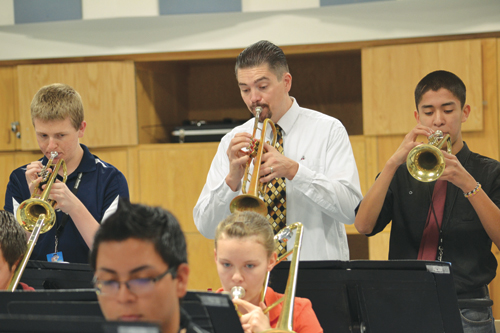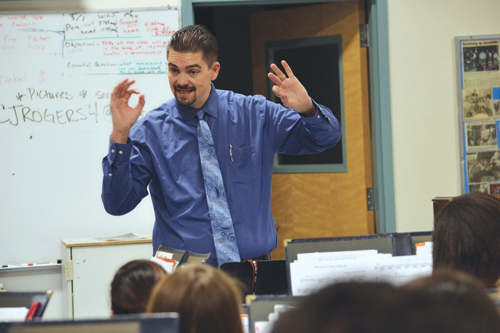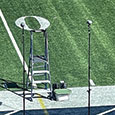
Martin Hebda is now in his 13th year teaching at Casa Grande Union High School in Arizona. His program has grown from 70 to 120 students during that time and ensembles at his school include marching band, two concert bands, jazz band, color guard, and percussion ensemble. He attended the University of Arizona and also taught at Salpointe Catholic High School in Tucson. Hebda has arranged music for a wide range of ensembles, including marching bands, percussion ensembles, vocal groups, and church ensembles. Because some of his formative musical experiences took place in competitive marching band, he understands the value and limitations of competition in music. “Competition keeps students driving toward something. The competitive can be a negative aspect, but we do not approach competition with the mindset of being better than another group. The approach is that we want is to have our best show. Students like it.”
When did you realize that you were destined to teach music?
Drum corps sealed the deal for me in the early 1990s. I was in marching band at my high school, and after my sophomore year, I went to Drums Along the Rockies in Denver and watched a bunch of corps. I loved the marching and the music. Their performances were so much better than what a high school could produce. I saw some of the members walking around the stadium and realized that they weren’t any older than I was. I auditioned in the fall, and the next summer I marched with the Denver Blue Knights. I was the first person from my high school to march with a drum corps, and the next year I brought six more people to march with me.
Drum corps brings discipline. Anything you do requires inner discipline. I tell my band that discipline is unique to each person because each is in charge of his own discipline. I can tell students what they should do but ultimately they are responsible for the results. Drum corps is tough; it pushed me and made me focused. Because I played all summer, I came back as an improved musician and became a leader at my high school. It snowballed from there. I marched again the next summer and then went on to college. In college I looked more into orchestra and jazz, but I valued the two years I marched drum corps, and it brought that focus and discipline for all types of music.
What helps most to drive home the notion that discipline is each student’s responsibility?
This is my 13th year here. If I came in as a first-year teacher and expected the level of discipline that I do now, it would not happen. It develops over time. The director sets expectations, and sometimes the students push it further and can surprise you. I don’t tell students a lot of rules on the first day; we teach them as we go.
Every Tuesday during summer the band gets together to move for a while and play. During these summer chops classes, when we stand in horn arcs the returning members will stand the correct way. The newcomers want to fit in, so they follow by example. Freshmen want to be like everyone else, so it does not matter whether they are disciplined coming in. If I want greater discipline, I tell my returning members to step it up, and the newcomers will just join that. This approach makes the freshmen much less nervous when band camp arrives. In fact, by the time we get to band camp, I’m not really teaching them how to march as much as just fine tuning how to march.
That said, we do not have cuts in our program. I will take someone who is not a great marcher and work with them. Maybe it takes two years for them to be able to march in time, but I will work with them. The ideal is to develop each student.
I also do not see music as a win-at-any-cost activity. Once a student had a stroke early in the his senior year. He recovered quite well, and halfway through the marching season he was able to walk and hold his instrument and play. It was a big goal for him to know that I would let him on the field if he could walk and march. It didn’t matter how much of his form he regained – I just wanted him to have the opportunity to get back onto the field.
What should marching band directors consider when picking show music for the year?
When directors ask me to arrange music for them, I send them a form. One of the first questions on the form is “What do you want out of this show?” I want to know if the show is going to be halftime fun or competition. If it is competitive, are they aiming to compete in their state only or nationally?
After this decision is made, directors should get the design team together and start brainstorming show ideas and concepts. Some groups focus on music while others focus on general effect or visual. It is important to know what is driving decisions. Think about what your band has done in the past and whether you want to change gears. Some people like playing rock or classical music every year. Other schools like variety from year to year. Think not only of your goals but also the expectations of students. The show should be something kids can grasp and get excited about. It doesn’t matter what you choose if students are not excited about it. To me, the most difficult part of the fall show is picking a theme and choosing source music. Once I have that, the writing is easy.
Once you have an idea of the theme and source music, it is time to consider strengths and weaknesses of the group, an important step that is sometimes overlooked. If you want to play Mahler but lack strong brass, that may be a poor choice. Don’t feel like you have to use all of the source music. You can use just a piece of a song and adjust difficult rhythms for the level of the group as needed.
What are the keys to arranging for marching band?
When you work on music, you can get tunnel vision, and getting fresh eyes on an arrangement can be helpful. Ask questions of arrangers you know. Write a section and give it to someone to critique. When I go to regional honor bands, other teachers who know me from college will find time to pull me aside and ask me to look at their work.
It is okay to change the key from the original source music, although it can sometimes loses the bite of the original. When people want me to arrange for them, I ask about changing keys. Some people hate changing keys, even if it means their band is playing in E major.
Ranges should also affect choice of key. Sometimes lowering the key by a third can help the trumpets immensely, but care must be taken that the low brass parts do not get so low they become muddy. If you lower a key, know what you are going to lower it to before you start. If I lower a piece a third, I might write the arrangement in the original key and write parts a little high, knowing that when the key is changed the ranges will be perfect.
Just because you have the horses to play difficult music doesn’t mean everything has to be difficult. The best groups rarely write for their trumpets above a high G. If the trumpets play too high all the time, it buries the low end of the band.
It is more difficult writing for smaller groups. Don’t write things that are too complicated for the smaller groups, and avoid putting too much melodic responsibility on single players. If you write for a group with three trumpet players who are all average, you want to double melodic lines in that section.
For a novice arranger, it is better to start with stand tunes that an entire marching band show. My first arrangements were simple tunes with a low brass line and a melody being played by the higher instruments.
It is also worth considering how difficult it will be to put a section together versus how much reward will be gained from it. Something can be high energy and high in general effect without being the most complicated rhythm or passage. If it takes hours to put a passage together, it probably isn’t worth it.
What tricks have you learned over the years for writing for drumline?
We write an easier drumline book in the fall to focus on technique and then beef things up for winter drumline. The most common comment from music judges at competitions is that the battery is playing too much, too loud. too often. It is okay to have just a section of the drumline play. I don’t look for flashy runs as much as how the sections relate to and interact with each other. Early on in drum corps, there would be a drum solo, for which the drums would come to the front and play for a bit, then go back and the horns would come back in. Having percussion mixed with the winds is good. Having just a section of the battery play with a section of the pit is good. I like to see things coordinated.
The pit sounds muddy when voicings are too close together, whether on the keyboard you are writing for or between two different keyboards. If there are two contrasting melodies, one on vibe and one on marimba but they are in the same octave, they cancel each other out. Have one line in a different octave so it cuts through.
I try to have marimbas do similar things. If I have three marimbas, I will have them all playing different notes in a chord. It depends on the ability of the musicians as well. When arranging, I ask how many students they have who can play four mallets. I also ask whether there are students they are trying to ease into four-mallet playing. Parts can be written that introduce four-mallet playing.
Do not write for an instrument just because it is available. A school might have four xylophones, but it is rarely beneficial to use more than one. Too many xylophones gets clinky. Be especially careful of writing rolls on xylophone and glockenspiel.
As with parts for winds, ask and observe other arrangers for ideas. The man who writes our pit book has a master’s in composition and is on his way to earning a doctorate as well. When I rehearse the front ensemble, I pay attention to how he notates things and which effects work best. Do research on what others are playing. When you watch other bands, focus on their pit and percussion and mimic what sounds good.
How do you teach students to play with musicality?
I like to give students something to think about while they are playing. If you are playing a march and there is a part you want to be lively, you could have students think of a circus, with a clown jumping around. If the music has a back-and-forth between clarinets and horns, with the clarinets playing a beautiful, lyrical melody and the horns occasionally interjecting something darker, I might suggest a scene where a girl tells her boyfriend “I love you,” and ask how the other person should reply. Should it be the same volume? Should it be mumbled? It should be heard, so the rest of the ensemble should not cover that voice up. The director studies the score, but students only see their part, so they will often need such things pointed out.
I ask students what the music makes them picture, and sometimes students give extremely creative answers, but other times they are unsure. I would rather ask first and then will tell them what I envision if they have no ideas. Some of the younger players don’t have the ability to relate music to something, but by their sophomore or junior year, they can come up with good imagery.
I talk about playing expressively more and more these days. I would rather hear a wrong note or rhythm from someone who was playing musically than absolute perfect notes and rhythms without musicality. This is especially important in jazz, where playing correct notes and rhythms is meaningless unless it is done in the correct style.
I have a young jazz band this year, and we are getting down to the basics on this. I have gotten my trumpet out and played with them more this year than in all twelve of my previous years of teaching here put together.

What role does listening play in teaching students to play with better tone and style?
Students don’t realize how lucky they are. They are tired of hearing this, but when we were growing up, if we wanted to listen to a piece, we had to go to the library and maybe find a record after some diligent searching. In the internet age, almost everything is available online for them to hear.
Students should pay attention to how their instrument should sound. They will not know how to produce a characteristic sound on their own. If you say “play with a warm sound” they have no idea what that means. I bring upperclassmen in to play with students as much as I can. I also get some of my staff members to work individually with students who need to hear how their instrument should sound.
There are many options for lessons with listening. I have a list of good recordings of all the instruments, and once a day during concert band season I will play one of them so the whole band can hear the characteristic sound of an instrument. I have a projector, and it is no trouble to spend five minutes of class watching a video and commenting on it. I ask students what they notice. Students coming from middle school rarely are aware of what the instruments can do or even what the full range of an instrument is. Playing recordings helps teach them all these things; one favorite is the clarinet solo at the beginning of Gershwin’s Rhapsody in Blue.
How do you make the transition from hearing a great characteristic sound to producing their own?
One key is having students play with someone who is better than they are. This is where your best student leaders can really make the biggest difference. Have students play with someone else and try to match their sound. I saw this happen at a conference; the clinician had a beginner play a note, and then he played the same note with a beautiful tone before asking the beginner to try again. Just by listening and matching, the beginner was able to get closer to the clinician’s sound. The mechanics matter – air and embouchure are still important – but playing with someone better than you can be a big help.
Some students enjoy playing with the director; others are intimidated by the idea and would rather play with another student. Duets are also good for building technical ability. If your leaders are in the band room practicing, the underclassmen will see that and realize they need more practice, too. No one should ever feel like they are good enough and have nothing to practice.
What advice would you give to new teachers?
Enjoy your students. I don’t have students that I dislike. There will be students who try your patience or don’t follow directions well or aren’t as musical, but I care for all of my students, and that is how I know I am doing the right job.
It is important for a director to think through a philosophy of teaching. My goal is to prepare students for all walks of life. Some students continue to play in college and beyond, but few people major in music. So, I am simply preparing the majority of students for life and helping them have a good musical experience. Everything in band prepares you for life; just as you do not come late to rehearsal, you do not come late to work.
Have goals for each year. Everyone makes changes when they come in, but you do not have to make every desired change the first year. It is better to feel things out. I wanted to have a disciplined, regimented program, but my first year, the primary goal was to make band fun again. Then we started to grow, and the goal became pushing musicianship a little bit further. After ten years, the goals have changed and become more specific.
In marching band, the number one thing to do is surround yourself with a good staff. Many people try to find people based on where they marched or where they went to college, but it is better to choose good people who understand the values and goals you have for the program. There are great performers and marchers out there, but find someone who will gel with your staff; for us this means someone who will focus on the education of the students rather than only on winning. If your staff lacks camaraderie, then the students won’t have it either. I will take people who haven’t taught before; we can teach them to be good teachers. If you don’t have a staff, work with the district and boosters to find a way to get help; marching band should never be a one-man show. My program is what it is because of the staff.
If you are going into a new school, research the community. I learned about the history of the program, both the good times and difficult times. I learned what the traditions were and what the students and community thought was important. Think of the first semester you come in as still a period of learning what is going on.
Be consistent. Be fair. Be true.





